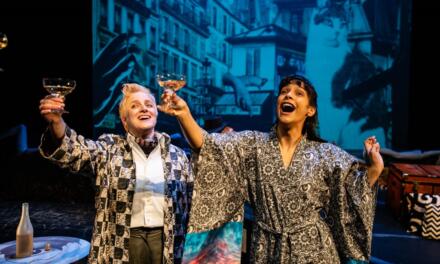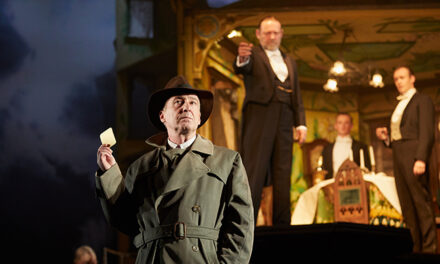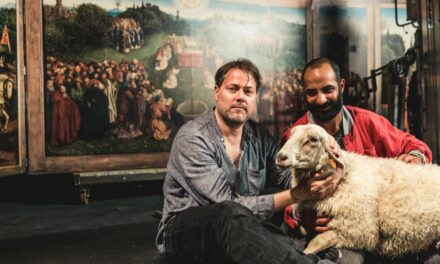La Cubana—one of Spain’s most important theatre companies—are back. They may have intimated back in 2016 that Gente bien (English title Good People) might be their final show but their newest show Adiós Arturo (English title Farewell Arturo), written and directed by Jordi Milán, shows that the company are still very much alive and kicking. La Cubana’s productions tend to follow one of two patterns: an extended run at one Barcelona theatre, as with Good People or a tour that takes in dates across all of Spain, as with Cegada de amor (English title Blinded By Love) which toured for over four years (1994-98). Farewell Arturo opened at Valencia’s Olympia theatre in May 2018 and has been touring since then—over 135,000 people have seen the show across 200 performances over the past 12 months. The first of the company’s productions not to open in Barcelona, plans are afoot for further dates across Spain through to late September 2019 before moving to a residency in Madrid’s Calderón theatre in October. A Barcelona run is planned for 2020.
It’s hard to miss La Cubana when the company comes to town. Playing at Bilbao’s flagship theatre, the Arriaga, currently, under the artistic direction of Catalan Calixto Bieito, the roads leading to the theatre are adorned with colorful yellow and pink banners announcing the show. Farewell Arturo takes the company’s habitual formula of appropriating a para-theatrical form—opera in Una nit d’òpera (English title A Night Of Opera), the TV talent show in Mamá, quiero ser famoso (English title Mummy, I Want To Be Famous), film in Blinded By Love—and turning it on its head to create a metanarrative.
For Farewell Arturo, the audience arrives at the Arriaga’s foyer to be greeted by an array of ushers (company performers) dressed in lurid colored suits. The box-office computers have broken down so they are assisting with the allocation of seats. Blocks of seating have been reserved for key mourners arriving for the funeral of the renowned polymath, Arturo Cirera Mompou: the Scottish Tap Dancing Association, the English Association of Friends of Bullfighting, the Friends of Haka Maori to name but three. Arturo (a figure invented by La Cubana) has died aged 101, an actor, artist, sculptor, poet, composer, musician, designer, writer, anthropologist, and philanthropist, he left clear instructions that his funeral service be as devoid of morbidity as his life. As such, he contracts La Cubana to run the funeral, much to the dismay of his biological family. Jaunty music is piped into the theatre and an upbeat atmosphere greets all mourners. A plethora or wreaths from the great and good—from Antonio Banderas to the Spanish Royal Family—litter the stage. As the audience take their seats, a few are taken to one side and asked if they would like to directly participate in the ceremony. Dressed as visiting dignitaries—members of royal families, church elders, ambassadors—and other friends of Arturo they emerge in their new attire to take their seats in the auditorium. The chief mourner is Arturo’s partner of forty years, a parrot named Ernesto, who is allocated a privileged place on the stage, placed immediately above the many medals awarded to Arturo during his extensive career which are on display on a plush red velvet board. A frosted glass coffin is a center stage, draped with the flag of Athletic Bilbao football team, a legendary institution in the city, and a sporting organization allegedly much loved by Arturo. (The Spanish flag was draped over the coffin in Valencia. At each venue, the flag of the local region is usually adopted. The script is adapted for each touring theatre which features as Arturo’s city or town of birth, so cementing the sense of belonging for the audience: the sense that he was “one of us.”) A large framed photo of Arturo floats down from the top, suspended immediately above the coffin. Even in death, he dominates the proceedings.
The stage is set for the celebration that Arturo requested. A chorus of eight—the men in blue, pink and yellow suits, the women in grey, orange, pink and cream dresses—perform a jolly musical number “Farewell Arturo,” composed by the company’s regular collaborator Joan Vives that reappears during the course of the production, celebrating Arturo’s curiosity and interests. The company members have chosen to front the ceremony mention that they are open for weddings, baptisms and now funerals as Good People is not able to tour. This is one of a number of references to the company’s previous work that litter the production, insider jokes for their returning audiences. A parallel here might be with Almodóvar who similarly balances broad appeal with a loyal audience. Key information about Arturo’s life is narrated with accompanying projections on the back screen. The son of a doctor who moved to Valencia from Bilbao, the family’s win of the state lottery in 1930 leads them to leave Spain and head for Paris where Arturo enters the city’s Conservatoire to train as a musician. (Conveniently the move to Paris evades any discussion of which side the family may have taken during the Civil War, a useful narrative trick that allows the piece’s politics to be articulated beyond the binary of the warring sides.) A grainy video of Arturo shot on VHS on his 70th birthday makes the plea for laughter and fun at his funeral. The colorful programme has a pull-out chronology of Arturo’s life—a document that avoids unnecessary dramatic exposition—to fill in any gaps. Dignitaries are introduced by name—and the audience members who agreed to take on the different roles, rise from their seat when summoned and wave to the assembled audience: the Ambassadors of France and Germany, a renowned Archbishop, a delegation from Athletic Bilbao Football Club, among others.
The latter, The World Association of Friends of “Pichichi,” named after the legendary player Rafael Moreno “Pichichi” Aranzadi (1892-1922), open the numerous “tributes to Arturo” vignettes that shape Act 1. Pichichi was part of Spain’s first national football team and won four Copas del Rey with the Basque club before dying of typhus at the age of 29. Pichichi is presented as Arturo’s godfather—Arturo’s father once having saved Pichichi’s father’s life. The Friends arrive in extravagant outfits. Decked out in Athletic Bilbao’s red and white stripe, they are led by a formidable spokeswoman (Babeth Ripoll) who guides the motley crew in a musical number with accompanying Athletic umbrellas—think The Umbrellas Of Cherbourg meets Match Of The Day—extolling the virtues of Athletic Bilbao. The audience sing along with gusto.
Different associations invited to give their tributes to Arturo then follow. The variety speaks of Arturo’s broad tastes. In an age of rigid categorization and a polarized “them and us” mentality where tribal affiliations—manifest in discussions of the Catalan separatist debate—appear ever more prominent, Arturo embraces a range of activities and interests. He refuses both in life and death to be compartmentalized. As such the rowdy football fans are followed by Spanish Association of Friends of Bel Canto—popular culture meeting a what is now seen as a rarified art form. The President of the Association is accompanied by his great friend Renata Pampanini (Jaume Baucis), one of the protagonists of the company’s A Night Of Opera who makes her grand appearance with a violet and silver jacket draped over a sparkling scarlet evening dress. A shiny opulent necklace completes the grand look. Renata is no longer as mobile as she once was, tottering across the stage with a walking stick, her grey wig held in place with a tiara looks a little like a bird’s nest. Rummaging in the coffin, she sings a painful if a heartfelt rendition of the “L’amour est un oiseau rebelle” aria from Carmen.
The English Association of Friends of Bullfighting is led by the doddery Lady Olivia Peterson (Nuria Benet), who removes her fur coat to perform Padilla’s “El relicario” (The relic) with accompanying fans and castanets in a pink and yellow suit of lights. Immortalized by Sara Montiel in her 1957 film El último cuplé (The Last Cuplé song), it’s a dramatic account of a woman who recounts her emotional encounter with a bullfighter who later perishes in the ring—the song featured as the song for Eisenhower’s presidential campaign in 1952. Lady Olivia’s crisp accent and fierce movements testifying to an international appropriation of this cultural form, across discourses of romanticism and cubism, and its legacy in the field of literature and painting across twentieth-century art practice.
The tributes continue. Don Arturo’s notary, Ignacio Búhó (búho is the Spanish for owl) (Toni Torres), represents the Association of Noah’s Ark, an animal lover’s club where dinners involve all members making animal noises—some of which the audience are treated to. Representatives from the Friends of Haka Maori speak of Arturo’s fascination with the Haka following his 1958 visit to New Zealand and his subsequent authoring of two books on Maori culture. Arturo’s position is presented not as simplistic cultural appropriation but rather positioned as the dissemination of practices that were unknown in Franco’s insular Spain. The cabaret stripper Katherine Rodríguez (a muse to the intellectual circle Le Dernier Cri of which Arturo was part) is modeled on Christa Leem (1953-2004), the legendary performer who was such an icon of 1970s Barcelona, inspiring poet Joan Brossa and artist Antoni Tapiès (among others); her portrait hangs in the bar of Barcelona’s legendary music hall venue, El Molino. Here Jordi Milan creates a character modeled on a Christa as she may have aged: Katherine sports dark glasses and a leopard print jacket as she sings “My heart belongs to daddy” in a rasping tone over the coffin; her granddaughter in a pink satin strapless dress and matching stole recreates her famous striptease number. The Scottish Tap Dancing Society bring a bagpipe player in a tartan suit with long hair flapping around his face, and a lithe dancer in a kilt to perform a number that moves from a Celtic reel to Broadway tap. Lupita Olivares sings in French. Cultural traditions travel and meld. Artistic fusion is prioritized over a culture of rarefied purity. Traditions shift as they are re-appropriated. Farewell Arturo suggests that culture should not be ossified but rather operate as a fluid entity, negotiated through ethical and informed engagement.
The Athletic Bilbao number was prepared for the Bilbao run—part of the company’s commitment to ensuring the piece responds to the locality where the production plays. In Valencia, the opening number had featured an association of responsible for organizing the falla (the giant paper-máché caricatured firecracker ninots) burned on March 19 each year. The focus on community and shared references that the audience recognize is part of the production’s celebratory ethos. Catholicism may celebrate life after death but its funerary rites don’t feel particularly joyful, something Arturo is determined to address in his own choices.
And joy is at the center of the production; from the Association of Drag Artists who haven’t performed together in decades who provide their own gloriously camp rendition of the Farewell Arturo number to Lupita Olivares, the throaty Mexican ranchero singer who articulates a bond of friendship that has survived over decades. Arturo’s longtime neighbor Herminia Soler Paredes (Montse Amat) and chauffeur Rashid El-Halili (Edu Ferrés), the “alternative” family, are interspersed with the many professional associations Arturo supported. Herminia speaks of seventy years spent living next door to Arturo with just a wall between them. A keen amateur tuba player she bids him farewell with a brief but intensive number on the tuba, an instrument she has not yet quite mastered. Arturo has been like a surrogate father to Rashid, offering him a job on meeting him in Tangiers. The extended coterie of nephews and nieces may seek to present themselves as the “legitimate” family but Farewell Arturo presents the family as a pliable concept that cannot exclusively be linked to blood ties. The blood family may be suspicious of Rashid and Arturo’s relationship—which they present in terms of sexual dependency or economic exploitation—but it is shown to be a warm, intergenerational platonic friendship that enriched both men’s lives. Herminia and Rashid also show consideration for the parrot Ernesto that the family—obsessed with their appearance and securing their fifteen minutes of fame—can not comprehend. The Cuban music-hall singer Caridad Muntaner, a Tina Turner lookalike who arrives on stage a little the worse for wear in a royal blue sequined dress and large white-rimmed glasses, teeters and swings as she sings of life like a carnival. The Cuban-Spanish axis—Castro declared a week of mourning when Franco died and Manuel Fraga, later a People’s Party politician was a great friend of Castro’s—and Arturo and Caridad forge a cultural alliance that matches that of Castro and Franco.
When the funeral service ends, Act 2 begins. Three hours have passed and three cleaners are sweeping up the stage. Cleaners often feature as characters in La Cubana’s shows, down to earth pragmatists who deflate the pretensions of some of the artists who often feature in the productions. “La Cubana are a dirty bunch,” says one of the cleaners as she clears some of the confetti from the stage. “Flowers are for the living more than the dead” retorts another of the trio. These are Hamlet’s gravediggers transplanted to our contemporary era with Ernesto repeating their words of wisdom so that they echo once more through the auditorium. “There’s a bit of theatre in funerals” one observes of the trio as Buhó returns to read out Arturo’s will and testament: twenty percent of his wealth goes to the numerous associations who popped up during the funeral service. The family receives ten percent and Ernesto receives the remaining seventy percent. There are some farcical shenanigans over a medal which one of the cleaners appropriates and much furor from the celebrity craving family who are indignant that Herminia has been designated Ernesto’s tutor with responsibility for his welfare. As Rashid and Herminia take off with Ernesto, Elisabet struggles to come to terms with her uncle’s decision. “What have I done to deserve this?” she exclaims, echoing the title of Almodóvar’s 1985 black comedy. The production’s final act shows that she has received the fate she deserves.
Arturo’s promotion of an ideal of kinship stands in contrast to the family’s wish to exclude his friends and associates from the funeral. The family is presented as misguided in Acts 1 and 2, only in Act 3 does their avarice really materialize. Hindsight produces a new reading of their conduct in Acts 1 and 2. The family insists on wearing black despite Arturo’s instructions otherwise and clutter around the coffin, like the bees around a honey pot. Their prominence in the performance final act—after the end of the funeral clear-up, the action moves back three days to the family congregating in Arturo’s flat where they search for valuables as their uncle lies on his deathbed. The ornate green backdrop with its rococo detail and Roman columns contrasts with the décor embodied across the characters’ bodies through Act 1’s celebration. The funeral exuded energy, Arturo’s living-room is a two-dimensional space where the family haggles over the paintings, jewelry, and trinkets. The friends and associates who had performed and provided homages at the funeral appear at his home to make their farewells, but are quickly sent away by the family. “We must play the family,” says his niece Elisabet (Babeth Ripoll) as an array of great-nephews and nieces come and go. Their attempts to control social media notifications of his death all backfire.
Nepotism, a key issue in Spain’s corruption scandals, is shown to bring terrible consequences. A great-nephew on a student placement at Barcelona’s La Vanguardia newspaper is entrusted with the announcement of Arturo’s death but miscommunication means that the news gets out before his death. Fake news is great-nephew Javier’s raison d’être and serves to position Sebastián and Elisabet, alongside Spain’s previous king whom they reference, as irresponsible figureheads. Forgetting Arturo’s birthday, they ignore his parrot, an animal at the center of Arturo’s world and then unbeknown to them, the main beneficiary of his estate. When avarice and materialism are prioritized, issues of humanity, welfare, and compassion are side-lined.
There are sly references to Spain’s dictatorship through the production. The censoring/retitling of the title of Arturo’s novel testifies to a regime with anxieties around bawdy language. Reference is made to the cover-ups—both sexual and political—of the prudish dictatorship. The women singers whose careers Arturo championed and whose friendship he valued point to the importance of a female agency which was not recognized or encouraged by the dictatorship. At a time when Franco embraced the values of a stay home hispanidad, Arturo welcomed different cultural traditions, acknowledging and developing his own work within a broader milieu. Watching Arturo on VHS, I was reminded of Fernando Fernán-Gómez, the actor, writer, and director who proved so influential on Spanish culture in the years between 1942 and his death in 2007. Santiago Rusiñol, the author of Good People, may have been another model for Arturo.
Developed over four months, Milán abandoned his plans for an animatronic parrot during the rehearsal period, training three parrots instead. Two alternate in the production with a third companion in tow. The show brings in two new performers, Edu Ferrès and Virginia Melgar, who accompany Cubana regulars, Jaume Baucis (superb as Renata Pampanini, the Haka lead and Arturo’s cantankerous nephew Sebastián), Nuria Benet (Lady Olivia Peterson, Katherine’s granddaughter the stripper Lili Lirio, the pragmatic cleaner Paqui), Babeth Ripoll (the flustered Elisabet, Amparo the cleaner), Montse Amat (Herminia the neighbour, Katherine Rodríguez, and Carmen the third cleaner), Toni Sans (Alberto San Román, the Scottish reel dancer, one of the drag artists), Xavi Tena (the Master of Ceremonies, Javier and a drag artist), and Toni Torres (Ignacio Búho, the bagpipe player, and Antonio, one of Arturo’s great nephews). Each actor takes on at least five roles and the speed of the changes —aided by big wigs, backstage choreography, and costume changes that are meticulously timed—provides a dizzying array of entertaining characters who form the backbone of the narrative. Leo Quintana’s choreography is wickedly funny working in tandem with Joan Vives’ upbeat score. Farewell Arturo asks its audience to think out of the box, to aim high and to promote a life where individualism takes second fiddle to friendship and community. It’s a welcome message in troubled times.

The ensemble cast of La Cubana post-funeral in Farewell Arturo. Photo: Josep Pla.
Farewell Arturo is on tour across Spain with dates at Madrid’s Calderón theatre from October 9, 2019.
This post was written by the author in their personal capacity.The opinions expressed in this article are the author’s own and do not reflect the view of The Theatre Times, their staff or collaborators.
This post was written by Maria Delgado.
The views expressed here belong to the author and do not necessarily reflect our views and opinions.


















